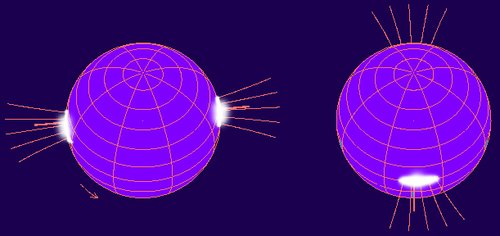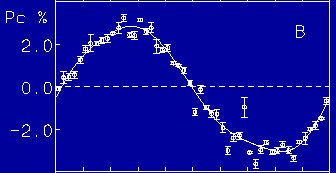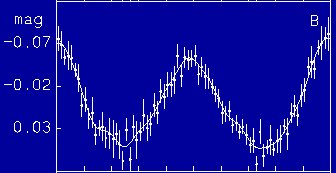

|
An international team of astronomers, led by Vilppu Piirola of Tuorla Observatory, have made extensive observations of a faint white dwarf star in Auriga, showing it has a very high magnetic field, the highest known for a star of its kind. The star, V405 Aur, was discovered by the ROSAT X-ray satellite, and subsequent observations indicate that it probably belongs to the class of white dwarfs called "Intermediate Polars". These are systems of two stars, one of which is a "white dwarf", a star which has ceased to generate its own energy and is fading slowly from view; and a "red dwarf", a star which is still generating energy, but at a very low rate, making it also very dim. In systems like this, the low mass red dwarf star is close enough to the heavier and much denser white dwarf, that material can flow from the lower mass star into a disc of matter before eventually falling onto the white dwarf, resulting in the high energy emission in the X-ray regions. In V405 Aurigae's case, the stars are so close together that they circle each other is just 4.15 hours. Now, Vilppu Piirola, Tommi Vornanen, Andrei Berdyugin (of Tuorla Observatory) and George Coyne, S.J. (of the Vatican Observatory) have been able to put together a detailed picture of the system by monitoring how the brightness and polarisation of the star's optical light changes during several full rotations of the system with the Nordic Optical Telescope. What they saw indicates that the white dwarf has a very strong magnetic field indeed. |

|
|
Illustration of the magnetic white dwarf in V405 Aur, showing cyclotron emission arcs near the magnetic poles. The two orientations of the spinning white dwarf correspond to circular polarization zero-crossings (left) and the maximum (right), seen in the figure below. |
|
Polarised light from these stars is a classic indicator of the presence of a magnetic field. In V405 Aur case, the polarised light varies with an amplitude of near 3 percent with almost perfect sinusoidal regularity right across the visible spectrum, and is particularly strong in the blue (light at about 450 nm). Polarisation levels this high are rarely seen: indeed, the observations indicate that this may be the strongest magnetic field ever seen in such a star to date, with estimates of the field strength being about 30 million Gauss. The magnetic field of the Earth is a little less than 1 Gauss in strength. |

|
|
Circular polarization variations over the 9.1 min spin period of the white dwarf in V405 Aur in the blue spectral region. |

|
|
The corresponding brightness variations in the blue spectral region for the 9.1 min spin period of V405 Aur. |
|
In the enormous magnetic field of V405 Aur the hot and magnetized plasma emits optical and near-infrared cyclotron emission, characterized by the base frequency and harmonic overtones. These allow an accurate measure of the magnetic field, B = 31.5 +/- 0.8 million Gauss, as determined by spectropolarimetry at the Nordic Optical Telescope. The magnetic field in this object is very similar to another type of white dwarf and red dwarf pair known as a "polar". In these systems, the matter stripped from the red dwarf isn't held up on the way in a circumstellar disk, but falls directly onto the white dwarf. Furthermore the stars are in synchronised rotation, so that the magnetic fields strongly influence how the matter falls onto the white dwarf, often striking it in a few 'hotspots'. Speculation over the years has been that Intermediate Polars can evolve into Polars given time, perhaps a few billion years. V405 Aur represents an important discovery, because it appears to be a system evolving toward just such a state. The study of V405 Aur has been accepted for publication in the Astrophysical Journal, and is available on line at http://arxiv.org/abs/0805.4289. For more information, please contact Dr. Vilppu Piirola, Tuorla Observatory.
|